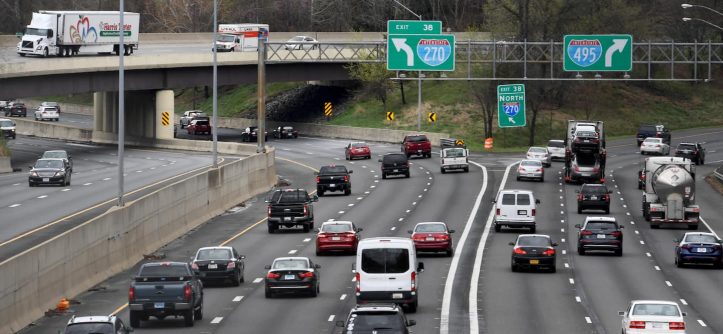Americans have begun leaving home more often than before the coronavirus pandemic took hold, reflecting a pent-up desire to venture out as new cases have declined, according to University of Maryland researchers tracking the movement of cellphones. The number of daily trips per person — when a cellphone moved more than a mile from home — had hovered around 90 percent of pre-pandemic levels since rebounding over the summer. But by mid-February, after a slight slump amid a surge in new cases, the number regularly started to exceed pre-pandemic travel.By the first week of March, the number of trips surpassed those taken each day in the same week last year, before stay-at-home orders kicked in, by as much as 13.6 percent.With such orders having long expired and barely 10 percent of the country fully vaccinated , Americans are demonstrating a growing comfort with heading out, likely the result of declines in new coronavirus cases , hospitalizations and deaths, researchers said. Reaching the first anniversary of pandemic-related restrictions might also have created more severe cases of early spring fever, experts say.The number of daily trips per capita has climbed even as an estimated 22 percent of the country continues to work from home. That’s because the number of nonwork trips, such as running errands, has jumped, on some days by as much as 20 percent compared with before the pandemic.It’s quarantine fatigue — and then some.“We’ve been through a long winter and a lot of [covid] cases,” said Mofeng Yang, the lead researcher on the Maryland Transportation Institute project . “People might want to escape from their homes.” Summer traffic rebounded to about 90 percent of pre-pandemic levels, analysts say Yang said the aggregated cellphone data doesn’t show where people are going, but he suspects many are more eager for a change of scenery than a year ago. Those working from home also probably have more flexibility than before to make personal trips, such as running errands or driving to a park for a walk, he said.Traffic analysts at Inrix, a Seattle-area firm that collects data on passenger vehicles, have found the number of miles driven daily nationwide remains at about 90 percent of pre-pandemic levels.Unlike the University of Maryland research, the Inrix data doesn’t include truck drivers and people who travel by transit, bicycle, plane or on foot. The national average also might be depressed by traffic remaining down significantly in many major metropolitan areas, such as New York and San Francisco, Inrix said.Inrix analyst Bob Pishue said he’s curious how much the growth in driving distances reflects people who have left large cities for smaller cities, suburbs and more rural areas where people tend to drive farther.Fifteen of the 100 metropolitan areas that Inrix monitors in the United States are seeing people drive farther than this time last year, most of them in less populous areas, such as Knoxville, Tenn., Greenville, S.C. and Boise, Idaho. “Quarantine Fatigue”: When U.S. residents started defying stay-home orders Washington-area residents are staying home more than the national average, taking an average of 3.4 trips per person on March 3 compared with 4.02 trips that day nationwide, according to the University of Maryland data. They also are continuing to take fewer trips than before the pandemic, remaining down between 1.5 percent and nearly 10 percent per capita, depending on the jurisdiction.District residents are staying home the most, with daily trips down 9.6 percent.Even with the number of coronavirus cases declining, public health experts continue to recommend limiting travel. Venturing out leads to more interactions among people of different households, increasing the chances of catching or spreading the virus.But some also say they are not surprised that people are leaving home more often.Lorien Abroms, a public health professor at George Washington University, said she suspects people are adding back trips they put off for the past year, now that they feel safer to do so.“I think people have pent-up energy to get out of the four walls of their house that they’ve looked at day after day for a year now,” Abroms said.States that are starting to fully reopen, including those like Texas that have lifted all restrictions, also are signaling “that it’s okay to travel and go out and do things you’ve been wanting to do,” she said. D.C. sees largest drop in pandemic traffic of major U.S. cities, analysts say How carefully people behave — whether they continue to wear masks, socially distance and stay outdoors as much as possible — is more important than how often they leave home, some experts said.“If it’s people running errands or driving to parks to walk outside or visiting people in their homes — those are all different risks,” said Amanda Castel, a George Washington University epidemiology professor.Castel said she’s worried about another surge this spring, when people travel longer distances to be with family and friends for Passover, Easter and spring break amid emerging variants and a mostly unvaccinated public.“It’s a critical time period for us,” she said. The coronavirus pandemic emptied America’s roadways. Now speeders have taken over. Months of pandemic teleworking have left some missing their commutes Local newsletters: Local headlines (8 a.m.) | Afternoon Buzz (4 p.m.) Like PostLocal on Facebook | Follow @postlocal on Twitter | Latest local news
Americans have started leaving home even more than before the pandemic, cellphone data shows





Leave a Reply